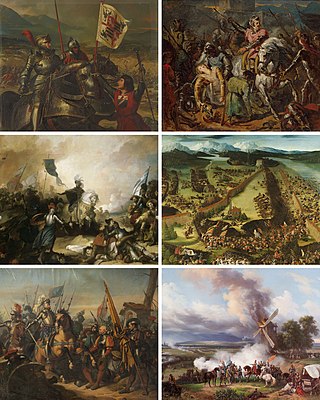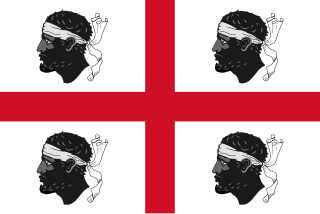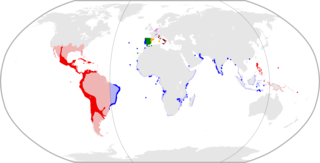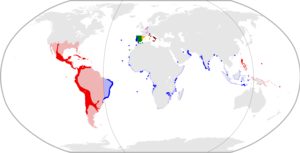
Charles III was King of Spain in the years 1759 to 1788. He was also Duke of Parma and Piacenza, as Charles I (1731–1735); King of Naples, as Charles VII; and King of Sicily, as Charles III (1735–1759). He was the fourth son of Philip V of Spain and the eldest son of Philip's second wife, Elisabeth Farnese. He was a proponent of enlightened absolutism and regalism.

The Italian Wars were a series of conflicts fought between 1494 and 1559, mostly in the Italian Peninsula, but later expanding into Flanders, the Rhineland and Mediterranean Sea. The primary belligerents were the Valois kings of France, and their Habsburg opponents in the Holy Roman Empire and Spain. At different points, various Italian states participated in the war, some on both sides, with limited involvement from England and the Ottoman Empire.

The Kingdom of Naples, also known as the Kingdom of Sicily, was a state that ruled the part of the Italian Peninsula south of the Papal States between 1282 and 1816. It was established by the War of the Sicilian Vespers (1282–1302), when the island of Sicily revolted and was conquered by the Crown of Aragon, becoming a separate kingdom also called the Kingdom of Sicily. This left the Neapolitan mainland under the possession of Charles of Anjou. Later, two competing lines of the Angevin family competed for the Kingdom of Naples in the late 14th century, which resulted in the death of Joanna I by Charles III of Naples. Charles' daughter Joanna II adopted King Alfonso V of Aragon as heir, who would then unite Naples into his Aragonese dominions in 1442.

The Duchy of Milan was a state in Northern Italy, created in 1395 by Gian Galeazzo Visconti, then the lord of Milan, and a member of the important Visconti family, which had been ruling the city since 1277.

The Duchy of Parma and Piacenza was an Italian state created in 1545 and located in northern Italy, in the current region of Emilia-Romagna.

The Habsburg monarchy, also known as Habsburg Empire, or Habsburg Realm, was the collection of empires, kingdoms, duchies, counties and other polities that were ruled by the House of Habsburg. From the 18th century it is also referred to as the Danubian monarchy or the Austrian monarchy.

The history of early modern Italy roughly corresponds to the period from the Renaissance to the Congress of Vienna in 1814. The following period was characterized by political and social unrest which then led to the unification of Italy, which culminated in 1861 with the proclamation of the Kingdom of Italy.

The Italian Wars of 1499–1504 are divided into two connected, but distinct phases: the Second Italian War (1499–1501), sometimes known as Louis XII's Italian War, and the Third Italian War (1502–1504) or War over Naples. The first phase was fought for control of the Duchy of Milan by an alliance of Louis XII of France and the Republic of Venice against Ludovico Sforza, the second between Louis and Ferdinand II of Aragon for possession of the Kingdom of Naples.
The Italian word luogotenente is an etymological parallel to lieutenant, deriving from the Latin locum tenens "holding a place", i.e. someone who fills a position instead of another, as a substitute or deputy.

The State of the Presidi was a small territory on the Tuscan coast of Italy that existed between 1557 and 1801. It consisted of remnants of the former Republic of Siena—the five towns of Porto Ercole and Porto Santo Stefano on the promontory of Monte Argentario, as well as Orbetello, Talamone and Ansedonia—and their hinterland, along with the islet of Giannutri and the fortress of Porto Longone on the island of Elba.

The Kingdom of Sardinia, also referred to as the Kingdom ofSardinia-Piedmont or Piedmont-Sardinia as a composite state during the Savoyard period, was a country in Southern Europe from the late 13th until the mid-19th century.

The Council of Aragon, officially, the Royal and Supreme Council of Aragon, was a ruling body and key part of the domestic government of the Spanish Empire in Europe, second only to the monarch himself. It administered the Crown of Aragon, which was composed of the Kingdom of Aragon, Principality of Catalonia, Kingdom of Valencia, Kingdom of Mallorca, and finally the Kingdom of Sardinia. The Aragonese possessions in Southern Italy were later incorporated into the Council of Italy, together with the Duchy of Milan, in 1556. The Council of Aragon ruled these territories as a part of Spain, and later the Iberian Union.

From 1700 to 1720, the Kingdom of Sardinia, as a part of the Spanish empire, was disputed between two dynasties, the Habsburgs and the Bourbons. With the death of Charles II, the last of the Spanish Habsburgs, on 1 November 1700, the throne passed to Duke Philip of Anjou, although the Emperor Leopold I also had a claim. Leopold was especially desirous of obtaining the Spanish inheritance in the Southern Netherlands and in Italy, which included Sardinia. With the failure of France to abide by the Second Partition Treaty, the other European powers lined up on the side of the Habsburgs. The Treaty of the Hague allotted to the Emperor the Spanish possessions in Italy. Imperial troops invaded Italy to seize them, and the War of the Spanish Succession began.
The Spanish monarchs of the House of Habsburg and Philip V used separate versions of their royal arms as sovereigns of the Kingdom of Naples-Sicily, Sardinia and the Duchy of Milan with the arms of these territories.

The Polysynodial System, Polysynodial Regime or System of Councils was the way of organization of the composite monarchy ruled by the Catholic Monarchs and the Spanish Habsburgs, which entrusted the central administration in a group of collegiate bodies (councils) already existing or created ex novo. Most of the councils were formed by lawyers trained in academic study of Roman law. After its creation in 1521, the Council of State, chaired by the monarch and formed by the high nobility and clergy, became the supreme body of the monarchy. The polysynodial system met its demise in the early 18th century in the wake of the promulgation of the Nueva Planta decrees by the incoming Bourbon dynasty, which organized a system underpinned by Secretaries of State.

The Empire of Charles V, also known by the umbrella term Habsburg Empire, included the Holy Roman Empire, the Spanish empire, the Burgundian Low Countries, the Austrian lands, and all the territories and dominions ruled in personal union by Charles V from 1519 to 1556. It was the first to be labelled as "the empire on which the sun never sets", a term used to describe several global empires throughout history. The lands of the empire had in common only the monarch, Charles V, while their boundaries, institutions, and laws remained distinct. Charles's nomenclature as Holy Roman Emperor was Charles V, though earlier in his life he was known by the names of Charles of Ghent, Charles II as Duke of Burgundy, and Charles I as King of Spain and Archduke of Austria. The imperial name prevailed due to the politico-religious primacy held by the Holy Roman Empire among European monarchies since the Middle Ages, which Charles V intended to preserve as part of his project to unite Christendom under his leadership.

The Treaty of Cateau-Cambrésis or Peace of Cateau-Cambrésis in April 1559 ended the Italian War of 1551–1559, the last of the Italian Wars (1494–1559). It consisted of several separate treaties, the main two signed on 2 April by Elizabeth I of England and Henry II of France, and on 3 April between Henry and Philip II of Spain. Although he was not a signatory, the agreements were approved by Emperor Ferdinand I, since many of the territorial exchanges concerned states that were part of the Holy Roman Empire.

The Kingdom of Sardinia was a feudal state in Southern Europe created in the early 14th century and a possession of the Crown of Aragon first and then of the Spanish Empire until 1708, then of the Habsburgs until 1717, and then of the Spanish Empire again until 1720.















